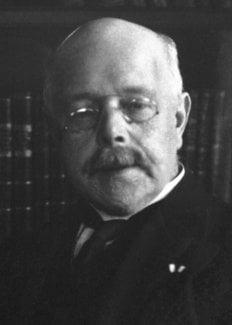Walther Nernst
Biographical

Walther Hermann Nernst was born in Briesen, West Prussia, on June 25, 1864. His father, Gustav Nernst, was a district judge. He spent his early school years at Graudentz, and subsequently went to the Universities of Zurich, Berlin and Graz (Ludwig Boltzmann and Albert von Ettinghausen), studying physics and mathematics, before proceeding to Wurzburg (Friedrich Kohlrausch), where he graduated in 1887 with a thesis on electromotive forces produced by magnetism in heated metal plates. He joined Wilhelm Ostwald at Leipzig University, where van ‘t Hoff and Arrhenius were already established, and it was in this distinguished company of physical chemists that Nernst began his important researches.
In 1894 he received invitations to the Physics Chairs in Munich and in Berlin, as well as to the Physical Chemistry Chair in Göttingen. He accepted this latter invitation, and in Göttingen founded the Institute for Physical Chemistry and Electrochemistry and became its Director. In 1905 he was appointed Professor of Chemistry, later of Physics, in the University of Berlin, becoming Director of the newly-founded “Physikalisch-Chemisches Institut” in 1924. He remained in this position until his retirement in 1933.
Nernst’s early studies in electrochemistry were inspired by Arrhenius’ dissociation theory which first recognized the importance of ions in solution. In 1889 he elucidated the theory of galvanic cells by assuming an “electrolytic pressure of dissolution” which forces ions from electrodes into solution and which was opposed to the osmotic pressure of the dissolved ions. In the same year he derived equations which defined the conditions by which solids precipitate from saturated solutions. His heat theorem, known as the Third Law of Thermodynamics, was developed in 1906. It demonstrated that the maximum work obtainable from a process could be calculated from the heat evolved at temperatures close to absolute zero – earlier ideas had not considered the effects of temperature – and conditions of equilibrium in many chemical reactions could now be precisely worked out. In addition to its theoretical implications, the theorem was soon applied to industrial problems, induding calculations in ammonia synthesis.
Nernst and his students in Berlin proceeded to make many important physico-chemical measurements, particularly determinations of specific heats of solids at very low temperatures and of vapour densities at high temperatures. All these were considered from the point of view of quantum theory.
In 1918 his studies of photochemistry led him to his atom chain reaction theory. This assumed that once the energy of a quantum has initiated a reaction in which free atoms are formed, these formed atoms can themselves decompose other molecules with the liberation of more free atoms and so on. The reaction can thus continue for long periods without further outside initiations.
Nernst was mechanically minded and he was always to the forefront in considering ways of applying the results of scientific research to industry. His improved electric light, the Nernst Lamp, used a ceramic body and it might have assumed importance had not tantalum and tungsten filaments been developed. His electrical piano, which replaced the sounding board with radio amplifiers, did not gain acceptance among musicians. In later years, he occupied himself with astrophysical theories, a field in which the heat theorem had important applications.
For his work in thermochemistry he received the Nobel Prize in Chemistry for 1920. Many other distinctions and awards were bestowed upon him for his contributions to science.
Walther Nernst’s fundamental contributions to electrochemistry, the theory of solutions, thermodynamics, solid state chemistry and photochemistry are recorded in a series of monographs, and in his many papers to learned societies, etc. His book Theoretische Chemie vom Standpunkte der Avogadro’schen Regel und der Thermodynamik (Theoretical chemistry from the standpoint of Avogadro’s rule and thermodynamics) was first published in 1893 and the tenth edition appeared in 1921 (the fifth English edition in 1923). Together with A. Schonflies he wrote a textbook Einführung in die mathematische Behandlung der Naturwissenschaften (Introduction to the mathematical study of the natural sciences), which reached its tenth edition in 1923. Of his other books, his monograph Die theoretischen und experimentellen Grundlagen des neuen Wärmesatzes (1918, second edition 1923) was also published in English (The New Heat Theorem, 1926).
Nernst married Emma Lohmeyer in 1892. They had two sons, who were both killed in the First World War, and three daughters. His favourite pastimes were hunting and fishing. He died on November 18, 1941.
This autobiography/biography was written at the time of the award and first published in the book series Les Prix Nobel. It was later edited and republished in Nobel Lectures. To cite this document, always state the source as shown above.
The Nobel Foundation's copyright has expired.Nobel Prizes and laureates
Six prizes were awarded for achievements that have conferred the greatest benefit to humankind. The 12 laureates' work and discoveries range from proteins' structures and machine learning to fighting for a world free of nuclear weapons.
See them all presented here.
